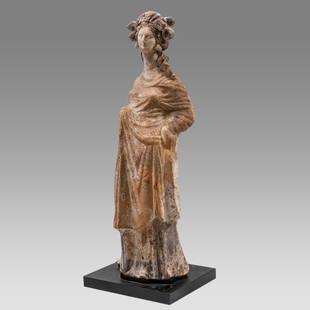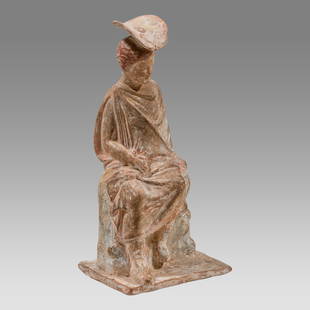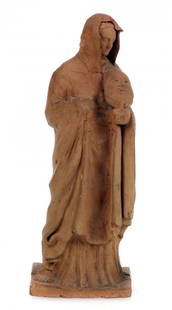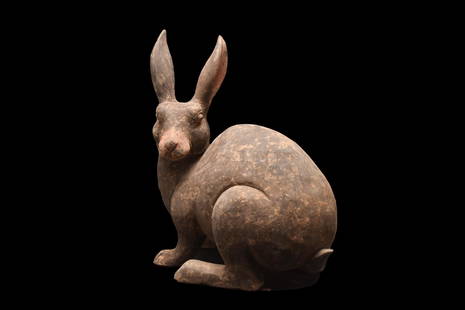
Published Greek Terracotta Antefix of Gorgon, ex-C. Ede
Similar Sale History
View More Items in Figurines & StatuettesRelated Figurines & Statuettes
More Items in Figurines & Statuettes
View MoreRecommended Decorative Objects
View More







Item Details
Description
Ancient Greece, ca. 540 BCE. Published on the front cover of Charles Ede Ltd Antiquities Catalogue 168 (a copy of which is included with this piece) with the following descriptions,"Greek circular antefix moulded with head of a gorgon, wreathed with snakes, her mouth open with tongue sticking out. Traces of polychrome decoration remain. Taras, 540 BC." The entry also mentions a comparison with S. Mollard-Besques, Musee National du Louvre Catalouge Raisonne des Figurines et Reliefs en Terrecuite . . . Vol. 1 (Paris 1954), pl. XLVII No. B522. Greek and Etruscan edifices typically included roof tiles that ran along the eaves and oftentimes terminated in upright members called antefixes. Such mold-made terracotta antefixes usually took the form of heads, either of humans or mythological creatures like this example. In addition to serving a decorative purpose, these architectural terracottas also covered and protected any exposed wooden sections of the building from the elements. This example, of a rounded shape, depicts a marvelous frontal head of a Gorgon, one of three mythological sisters of the ancient Greek world whose hideous visages embodied the most horrifying aspects of death and the supernatural, with wide open eyes, a pointy protruding nose, a disturbing toothy smile, large ears, a clefted chin, all surrounded by a serpentine wreath. Known for their potent gazes that could turn one to stone, Gorgons were favored as architectural ornaments because it was believed that they would protect those within. Perhaps the most famous image of a Gorgon is featured upon the pediment of the temple at Corfu, the oldest known pediment in Greece, preceding this example by only sixty years! Here we have an exquisite published example. Custom, museum-quality stand. Size: 6.5" L x 9" W x 8.5" H (16.5 cm x 22.9 cm x 21.6 cm)
Published: Charles Ede Ltd Antiquities Catalogue 168 (Charles Ede Ltd: London 2000). See front cover and description No. 11 .
Compare to S. Mollard-Besques, Musee National du Louvre Catalogue Raisonne des Figurines et Reliefs en Terrecuite . . . Vol. 1 (Paris 1954), pl. XLVII No. B522.
A similar antefix with the head of a gorgon was featured in Sotheby's New York, June 1994, lot 183 for $20,000. It was published in J.M. Padgett's "The Centaur’s Smile, The Human Animal in Early Greek Art", Princeton, 2004, pp. 324-325, n. 88. Similar terracotta head antefixes may also be found in renowned museum collections including the J. Paul Getty Museum and the Metropolitan Museum of Art.
Provenance: Ex-Private Orange County, CA collection, Ex Charles Ed Gallery, London.
All items legal to buy/sell under U.S. Statute covering cultural patrimony Code 2600, CHAPTER 14, and are guaranteed to be as described or your money back.
A Certificate of Authenticity will accompany all winning bids.
We ship worldwide to most countries and handle all shipping in-house for your convenience.
#118087
Published: Charles Ede Ltd Antiquities Catalogue 168 (Charles Ede Ltd: London 2000). See front cover and description No. 11 .
Compare to S. Mollard-Besques, Musee National du Louvre Catalogue Raisonne des Figurines et Reliefs en Terrecuite . . . Vol. 1 (Paris 1954), pl. XLVII No. B522.
A similar antefix with the head of a gorgon was featured in Sotheby's New York, June 1994, lot 183 for $20,000. It was published in J.M. Padgett's "The Centaur’s Smile, The Human Animal in Early Greek Art", Princeton, 2004, pp. 324-325, n. 88. Similar terracotta head antefixes may also be found in renowned museum collections including the J. Paul Getty Museum and the Metropolitan Museum of Art.
Provenance: Ex-Private Orange County, CA collection, Ex Charles Ed Gallery, London.
All items legal to buy/sell under U.S. Statute covering cultural patrimony Code 2600, CHAPTER 14, and are guaranteed to be as described or your money back.
A Certificate of Authenticity will accompany all winning bids.
We ship worldwide to most countries and handle all shipping in-house for your convenience.
#118087
Condition
A large fragment with surface wear and losses as shown.
Buyer's Premium
- 24.5%
Published Greek Terracotta Antefix of Gorgon, ex-C. Ede
Estimate $6,000 - $9,000
6 bidders are watching this item.
Shipping & Pickup Options
Item located in Louisville, CO, usSee Policy for Shipping
Payment
Accepts seamless payments through LiveAuctioneers

Related Searches
TOP


















































































